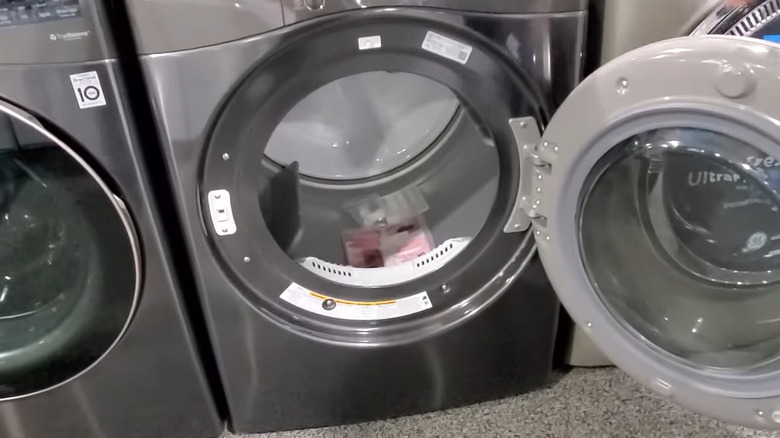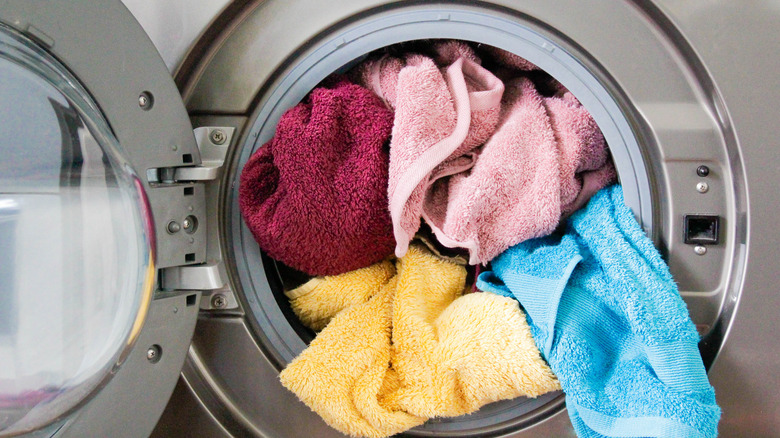The Smart Door Trick You'll Want To Use On Your Front-Load Washer And Dryer
Contrary to what might be your intuition, washer and dryer manufacturers don't actually want you to suffer. They go to great lengths to solve problems — that mold you have to clean off the rubber seal on a front-load washer, for example — and improve your experience with innovations like smart features and wash/dry cycle options that are expanding faster than the universe. But, of course, all of that doesn't mean they won't accidentally make your life more difficult. One way this unfortunate misery is induced comes via dealing with front-loading washer and dryer doors, which are often oriented in ways that can be frustrating.
Washer and dryer doors might collide with each other when open, or with walls. And, perhaps worst of all, that might get in the way of efficiently moving the wash from washer to dryer, forcing you to maneuver each handful of laundry over a door to get it into the dryer. In most cases, though, the washer and dryer makers have your back, though you might not know it. Most dryers and a few washers have a built-in reversibility, which means you can swap which side of the door is hinged. It would've been nice to know that about 400 loads ago, right?
In most cases, laundry machines are set up so that the washer is on the left, with a door opening to the left, and the dryer is on the right, with its door opening to the right, But there are cases — when using stackable washer and dryer sets, for example — when this arrangement does not work as seamlessly as intended. Don't worry; the appliance makers have you covered — partly, at least.
Swapping a dryer door
To help with this, manufacturers make the doors on most dryers reversible. It is, after all, usually unnecessary to reverse both doors. The easiest way to spot a reversible door is to look at the shape and screw pattern on both sides of the door. If they are mirrored, the door is almost certainly reversible, but it's always best to confirm this with your model's documentation before you start taking the dryer apart. Note that you might not be able to see the underlying screw pattern if there's a cover, usually plastic, over the recess or cavity into which the hinges will attach.
Changing a dryer door from right to left is usually essentially a matter of taking the door off and screwing it into matching holes on the opposite side of the appliance. You'll likely need a Phillips head screwdriver that matches the screws you'll be removing (most likely a #2 Phillips) and a slotted screwdriver or putty knife for a bit of prying. Unplug and open the dryer, then remove the plastic cover (if there is one) and any screw caps covering individual screws. Remove any screws in the side you're moving the hinge to. Remove the door. Depending on the model, you will either remove the hinges or leave them in place while simply flipping the door upside down. Then simply put all the pieces back together on their new, opposite sides. Many manufacturers offer online instructions for reversing their dryers' doors.
When you can (and can't) reverse a washer door
While most dryer doors can be reversed, not all can. The next logical step, in that case, is to reverse the washer's door — but that's unlikely to actually be possible. The reason is that door locking mechanisms, present on most washers and critical on front-loaders, can't easily swap sides. So, the models are made so that the doors can't be reversed. There are some exceptions, primarily among GE washers with UltraFresh vent systems and some Electrolux models.
Don't take anyone's word that a washer door is reversible without confirming it with the manufacturer. Some models are listed in various places online as having reversible doors when, in fact, they don't. We have seen Samsung, Miele, and other washers incorrectly described by retailer websites as having reversible doors.
If your washer's door can be swapped, the process is almost certain to be more complicated than it is for a dryer. On GE models, for example, you might also need to move the door striker assembly, terminal holder, pin assembly, and lock assembly. The process is involved and is model-specific, so you'll need your washer's installation manual for complete instructions.


